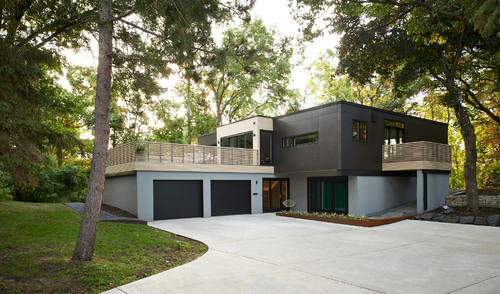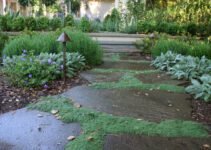Generally speaking the driveway is a functional aspect of our home, but its aesthetic appeal shouldn’t be ignored. A driveway is like a large welcome mat for our home. The driveway is the first impression of our home and improves the overall look and value of our home. Homeowners take great pride in the exterior of their home.

Photo by CHRISTIAN DEAN ARCHITECTURE, LLC – More exterior home photos
There are two categories of driveway: Solid Surface Driveway and Aggregate Surface Driveway. We can find sold surface driveways in asphalt top driveway (known like hot-top or black-top), and concrete top driveway.
The concrete driveway has become an essential part of a landscaping plan that imparts an inviting image. Concrete driveway proved to be suitable for fitting long outer surfaces. Concrete driveway is not only a robust, economical type of driveway, but also an option to enter into harmony with the environment.
Concrete is also the most common material used for driveways because of its appearance and durability. In addition to the traditional look, concrete have the decorative appearance. The finish could be: bricks, tiles, slates, stones or exposed aggregates.
In fact, concrete can be formed into practically any shape, texture, pattern or color.
A good planning and using the proper driveway materials are essential in getting a good road or driveway. Spending time in planning is always a wise decision. We need to consider the size and the shape of the driveway. Another important factor in getting a good driveway is a good drainage. To eliminate standing water, the driveway should be sloped towards the street a minimum 1%, or 1/8 inch per foot.
For a single-car driveway the width should be 8 to 9 feet and for two-car driveway the width should be 15 to 18 feet. However if the distance from the street to a two or more car garage is long enough we can take in consideration only a single-car driveway which can be widened near the garage and if we have enough extra space, we can plan an extra parking or a turn-around area.
The thickness of a concrete driveway depends of what kind of soil is being used under the driveway and should be made by gravel. The thickness of the gravel will depend on the climate where we live. We have to go deep with the gravel under the frost line. If we are living in a climate without a freezing winter then 12-18 inches of gravel is sufficient.
When the basic driveway design has been decided, the next step is site preparation. If we are dealing with an existing old driveway, first thing we need to remove the asphalt layer and taken away. We can use the old gravel underlay but only a part of it because, anyway, the new concrete driveway will be thicker and we need to maintain proper elevation. I mention already a good idea will be to pay attention to the drainage. It is far easier to build when we are not dealing with mud and poor drainage. Standing water will get into your base material and make mud pot.
The gravel base is compacted with a vibratory plate compactor. Lumber sides will create the shape of the driveway and will be placed and securely nailed in the ground with the stakes help. The new driveway has to match with the existing garage slab and sidewalk. Between the new driveway and the existing garage slab we need a thick pre molded joint.
The concrete for the area has to be accordance with the standards. We need to consult the ready mixed concrete producer for information.
However, for milder climates it could be a lower strength concrete. Ready mixed concrete should be delivered and discharged as quickly as possible, not more than 2 hours. In fact, the concrete should be placed as near as possible to its finished position. Concrete control joints are used to minimize random cracking in concrete slabs and floors. And for the concrete driveway itself we need joints at spacing no more than 10’ x 10’.
Concrete is shrinking, therefore the most important thing are the joints in concrete pavements. They control the location and spread of cracks. If they are wider than 10’ x 10’we can have cracks in our driveway. However there are many reasons why concrete cracks. They can be hand-tooled or saw cut. The concrete cracks usually occur due to omission of isolation and control joints, improper jointing practices, the use of very wet concrete (high slump) and inadequate or curing.
Placing and Finishing is the new step. We can spray, brush, and broom it. Properly concrete should allow finishing operations to begin almost immediately. Two main types of finish are used: hard – troweled and broom finish. Trowel finishes are usually used indoors where a smooth, hard and flat surface is required. Broom finishes are appropriate for exterior slabs such as sidewalks, offering durability and a slip resistant surface. Decorative finishes are also available, including: Patterned, Colored and Exposed Aggregate.
Curing is one of the most important but unfortunately neglected phases of a good concrete construction. If we do not have a properly cured concrete, our driveway is more likely to crack and for sure will not be durable (failure to cure concrete can result in reductions of strength up to 50%). Curing of concrete is the final step of construction process.
Curing or keeping the surface moist to assure greatest hydration of cement and highest potential strength is easily done through spray membranes or other readily available products and procedures. Curing compounds should be applied after the final finishing operation to increase the concrete’s resistance to the effects of weather, and to decrease the occurrence of surface defects. Curing should last for at least 3 days, and as long as 7 days. In the colder climates, curing procedures may need to be adjusted.
Two of the great advantages for using concrete are its durability and ease of care. Periodically sealing a concrete driveway will protect it from water or chemical absorption. This will make it much easier to clean accidental spills, to absorb moisture and will also help prevent the occurrence of surface defects.
Always follow manufacturers’ recommendations for sealing concrete. There are many kinds of sealers and penetrating sealers. Some of them are liquid acrylic-based copolymers. They are transparent and act as a film over the surface. Penetrating sealers are clear, and penetrate deeply and chemically react with cement. They will be the best protection against moisture. The sealers can be applied by brush, roller or by using low pressure sprayer.
There are many factors when we chose for a concrete driveway:
– The concrete driveway has a beautiful appearance, especially when it is stained or stamped.
– Although the initial cost of a concrete driveway is more than an asphalt driveway, concrete life expectancy will be three times more than asphalt, that it means will be cheaper in the long run. We can mention also, less maintenance and resurfacing cost.
– The concrete surface is safer, especially when it is wet or in the winter time.
– The concrete driveway is more comfortable than asphalt driveway. Concrete will not up in the sun like asphalt.
It wasn’t long ago when deciding on a driveway material was easy: asphalt or concrete. Today, the “concrete” choice has expanded to include an astounding array of decorative options. Sometimes referred to as a cement driveway or as painted concrete, decorative concrete is one of the most reasonable ways to spruce up the entrance to your home. And do not forget.
Concrete is one of the most environmentally friendly construction material.
A Smart Choice for Your Home – Asphalt Driveway (howtobuildahouseblog.com)


